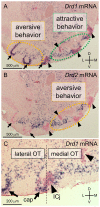Hypothetical Roles of the Olfactory Tubercle in Odor-Guided Eating Behavior
- PMID: 33262693
- PMCID: PMC7686465
- DOI: 10.3389/fncir.2020.577880
Hypothetical Roles of the Olfactory Tubercle in Odor-Guided Eating Behavior
Abstract
Olfaction plays an important role in the evaluation, motivation, and palatability of food. The chemical identity of odorants is coded by a spatial combination of activated glomeruli in the olfactory bulb, which is referred to as the odor map. However, the functional roles of the olfactory cortex, a collective region that receives axonal projections from the olfactory bulb, and higher olfactory centers in odor-guided eating behaviors are yet to be elucidated. The olfactory tubercle (OT) is a component of the ventral striatum and forms a node within the mesolimbic dopaminergic pathway. Recent studies have revealed the anatomical domain structures of the OT and their functions in distinct odor-guided motivated behaviors. Another component of the ventral striatum, the nucleus accumbens, is well known for its involvement in motivation and hedonic responses for foods, which raises the possibility of functional similarities between the OT and nucleus accumbens in eating. This review first summarizes recent findings on the domain- and neuronal subtype-specific roles of the OT in odor-guided motivated behaviors and then proposes a model for the regulation of eating behaviors by the OT.
Keywords: attractive behavior; aversive behavior; dopamine; eating; motivation; olfaction; olfactory tubercle; palatability.
Copyright © 2020 Murata.
Figures


Similar articles
-
Mapping of Learned Odor-Induced Motivated Behaviors in the Mouse Olfactory Tubercle.J Neurosci. 2015 Jul 22;35(29):10581-99. doi: 10.1523/JNEUROSCI.0073-15.2015. J Neurosci. 2015. PMID: 26203152 Free PMC article.
-
The olfactory tubercle encodes odor valence in behaving mice.J Neurosci. 2015 Mar 18;35(11):4515-27. doi: 10.1523/JNEUROSCI.4750-14.2015. J Neurosci. 2015. PMID: 25788670 Free PMC article.
-
Odor- and state-dependent olfactory tubercle local field potential dynamics in awake rats.J Neurophysiol. 2014 May;111(10):2109-23. doi: 10.1152/jn.00829.2013. Epub 2014 Mar 5. J Neurophysiol. 2014. PMID: 24598519
-
Neurochemical organization of the ventral striatum's olfactory tubercle.J Neurochem. 2020 Feb;152(4):425-448. doi: 10.1111/jnc.14919. Epub 2020 Jan 7. J Neurochem. 2020. PMID: 31755104 Free PMC article. Review.
-
Connectivity of the olfactory tubercle: inputs, outputs, and their plasticity.Front Neural Circuits. 2024 May 22;18:1423505. doi: 10.3389/fncir.2024.1423505. eCollection 2024. Front Neural Circuits. 2024. PMID: 38841557 Free PMC article. Review.
Cited by
-
An experimental framework for conjoint measures of olfaction, navigation, and motion as pre-clinical biomarkers of Alzheimer's disease.J Alzheimers Dis Rep. 2024 Dec 23;8(1):1722-1744. doi: 10.1177/25424823241307617. eCollection 2024. J Alzheimers Dis Rep. 2024. PMID: 40034341 Free PMC article. Review.
-
Olfactory deficits in aging and Alzheimer's-spotlight on inhibitory interneurons.Front Neurosci. 2024 Dec 16;18:1503069. doi: 10.3389/fnins.2024.1503069. eCollection 2024. Front Neurosci. 2024. PMID: 39737436 Free PMC article. Review.
-
Endogenous opioids in the olfactory tubercle and their roles in olfaction and quality of life.Front Neural Circuits. 2024 May 30;18:1408189. doi: 10.3389/fncir.2024.1408189. eCollection 2024. Front Neural Circuits. 2024. PMID: 38872907 Free PMC article. Review.
-
Structural Connectivity between Olfactory Tubercle and Ventrolateral Periaqueductal Gray Implicated in Human Feeding Behavior.J Neurosci. 2024 Jun 19;44(25):e2342232024. doi: 10.1523/JNEUROSCI.2342-23.2024. J Neurosci. 2024. PMID: 38755004 Free PMC article.
-
Cellular Profiles of Prodynorphin and Preproenkephalin mRNA-Expressing Neurons in the Anterior Olfactory Tubercle of Mice.Front Neural Circuits. 2022 Jul 22;16:908964. doi: 10.3389/fncir.2022.908964. eCollection 2022. Front Neural Circuits. 2022. PMID: 35937204 Free PMC article.
References
Publication types
MeSH terms
LinkOut - more resources
Full Text Sources

